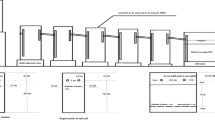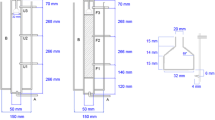Abstract
The aim of this paper was to present the influence of hydraulic behaviour in the treatment of sewage (domestic wastewater) using panelled anaerobic baffle-cum filter reactor (PABFR). The PABFR has five compartments of equal size in which the first three compartments operate as anaerobic baffled reactor (ABR) followed by anaerobic filters (AF). The combined reactor has a great potential for its application due to its panelled structure and arrangement of baffles inside each compartment. Hydrodynamic behaviour of the reactor was determined by means of a pulse tracer test and by calculating the residence time distribution curves at different flow rates. At high flow rates [with hydraulic retention time (HRT) <4 h], the mixing pattern in ABR showed a completely mixed type with a maximum dead space of 14 % and as the flow decreased (HRT of 8 and 12 h), the ABR’s mixing behaviour was intermediate between plug flow and completely mixed. In the case of AF, as the flow increased, the dispersion was intermediate between completely mixed and plug flow, and as the flow rate decreased, the reactor became completely plug flow with the dead space ranging between 2.2 and 7.4 %. On the whole, PABFR treatment performance in terms of chemical oxygen demand removal was 90, 89 and 64 % for 12-, 8- and 4-h HRT, respectively, which clearly shows the correlation between mixing and reactor process performance. Thus, the outcome of this research in general highlights the importance of hydrodynamic behaviour for a better operation of the reactor.




Similar content being viewed by others
References
American Public Health and Association (APHA) (1998) Standard methods for the examination of water and wastewater, 19th edn. United Book Press, USA
Barber WP, Stuckey DC (1999) The use of anaerobic baffled reactor (ABR) for wastewater treatment: a review. Water Res 33(7):1559–1578
Bodin H, Mietto A, Ehde PM, Persson J, Weisner S (2012) Tracer behaviour and analysis of hydraulics in experimental free water surface wetland. J Ecotechnol 49:201–211
Bodkhe SY (2009) A modified anaerobic baffled reactor for municipal wastewater treatment. J Environ Manag 90(8):2488–2493
Capela I, BiléM J, Silva F, Nadais H, Prates A, Arroja L (2009) Hydrodynamic behaviour of a full-scale anaerobic contact reactor using residence time distribution technique. J Chem Technol Biotechnol 84(5):716–724
Chen X, Zheng P, Guo Y, Mahmood Q, Tang C, Ding S (2010) Flow patterns of super-high-rate anaerobic bioreactor. Bioresour Technol 101(20):7731–7735
Feng H, Hu L, Shan D, Fang C, Dong S (2008) Effects of temperature and hydraulic residence time (HRT) on treatment of dilute wastewater in a carrier anaerobic baffled reactor. Biomed Environ Sci 21:460–466
Fogler HS (2006) Elements of chemical reaction engineering, 4th edn. Pearson Education, London
Gopala Krishna GVT, Kumar P, Kumar P (2008) Treatment of low strength complex wastewater using an anaerobic baffled reactor (ABR). Bioresour Technol 99(17):8193–8200
Grobicki A, Stuckey DC (1992) Hydrodynamic characteristics of the anaerobic baffled reactor. Water Res 26(3):371–378
Holland JF, Martin JF, Granata T, Bouchard V, Quigley M, Brown L (2004) Effects of wetland depth and flow rate on residence time distribution characteristics. Ecol Eng 23(3):189–203
Ji J, Zhe K, Xing Y, Zheng P (2012) Hydraulic characteristics and their effects on working performance of compartmentalized anaerobic reactor. Bioresour Technol 116:47–52
Ji Y-X, Xing B-S, Yang G-F, Ni W-M, Guo L-X, Jin R-C (2014) Performance and hydrodynamic features of a staged up-flow ANAMMOX sludge bed (SUASB) reactor. Chem Eng J 253:298–304
Jimenez B, Noyola A, Capdeville B (1988) Selected dye for residence time distribution evaluation in bioreactors. Biotechnol Tech 2(2):77–82
Kobayashi T, Li Y-Y (2011) Performance and characterization of a newly developed self-agitated anaerobic reactor with biological desulfurization. Bioresour Technol 102(10):5580–5588
Leslie Grady CP, Daigger GT, Lim HC (1999) Biological wastewater treatment, 2nd edn. Marcel Dekker, New York
Levenspiel O (1999) Chemical reaction engineering, 3rd edn. Wiley, New York
Lindmark J, Thorin E, Fdhila RB, Dahlquist E (2014) Effects of mixing on the result of anaerobic digestion: review. Renew Sustain Energy Rev 40:1030–1047
Liu X, Ren N, Wan C (2007) Hydrodynamic characteristics of a four-compartment periodic anaerobic baffled reactor. J Environ Sci (China) 19(10):1159–1165
Mansouri Y, Zinatizadeh AA, Mohammadi P, Irandoust M, Akhbari A, Davoodi R (2012) Hydraulic characteristics analysis of an anaerobic rotatory biological contracto (AnRBC) using tracer experiments and response surface methodology (RSM). Korean J Chem Eng 28(7):891–902
Metcalf and Eddy (2003) Wastewater engineering: treatment, disposal, and reuse, 4th edn. McGraw-Hill, New York
Persson J, Somes NLG, Wong THF (1999) Hydraulics efficiency of wetlands and ponds. Water Sci Technol 40(3):291–300
Pritchard DW, Carpenter JH (1960) Measurements of turbulent diffusion in estuarine and inshore waters. Int Assoc Sci Hydrol Bull 5(4):37–50
Qi W-K, Hojo T, Li Y-Y (2013) Hydraulic characteristics simulation of an innovative self-agitation anaerobic baffled reactor (SA-ABR). Bioresour Technol 136:94–101
Rajakumar R, Meenambal T, RajeshBanu J, Yeom IT (2011) Treatment of poultry slaughterhouse wastewater in upflow anaerobic filter under low upflow velocity. Int J Environ Sci Technol 8(1):149–158
Ren TT, Mu Y, Yu HQ, Harada H, Li YY (2008) Dispersion analysis of an acidogenic UASB reactor. Chem Eng J 142:182–189
Sarathai Y, Koottatep T, Morel A (2010) Hydraulic characteristics of an anaerobic baffled reactor as onsite wastewater treatment system. J Environ Sci (China) 22(9):1319–1326
Smith CL, Elliot DJ, James A (1996) Mixing in upflow anaerobic filter and its influence on performance and scaleup. Water Res 30(2):3066–3076
Tembhurkar AR, Mhaisalkar VA (2006) Study of hydrodynamic behavior of a laboratory scale upflow anaerobic fixed film fixed bed reactor. J Environ Eng 48(2):75–80
Terashima M, Goel R, Komatsu K, Yasui H, Takahashi H, Li YY, Noike T (2009) CFD simulation of mixing in anaerobic digesters. Bioresour Technol 100(7):2228–2233
Thackston EL, Shields FD, Schroeder PR (1987) Residence time distribution of shallow basins. J Environ Eng ASCE 113(6):1319–1332
Tomlinson EJ, Chambers B (1979) The effect of longitudinal mixing on the settleability of activated sludge. Technical report TR 122, Stevenage, England
Tsai DDW, Ramaraj R, Chen PH (2012) A method of short-circuiting comparison. Water Resour Manag 26(9):2689–2702
Wolkersdorfer C (2011) Tracer test in a settling pond: the passive mine water treatment plant of the 1 B mine pool, Nova Scotia, Canada. Mine Water Environ. doi:10.1007/s10230-011-0147-3
Acknowledgments
The project was sponsored by University Grants Commission (UGC). The authors would like to thank the management of STP at the Anna University Campus for their cooperation throughout the study, and the authors extend their thanks to Ms. Anu Rachel Thomas and Ms. Sowmiya for their technical assistance during the study.
Author information
Authors and Affiliations
Corresponding author
Rights and permissions
About this article
Cite this article
Renuka, R., Mariraj Mohan, S. & Amal Raj, S. Hydrodynamic behaviour and its effects on the treatment performance of panelled anaerobic baffle-cum filter reactor. Int. J. Environ. Sci. Technol. 13, 307–318 (2016). https://doi.org/10.1007/s13762-015-0824-z
Received:
Revised:
Accepted:
Published:
Issue Date:
DOI: https://doi.org/10.1007/s13762-015-0824-z




